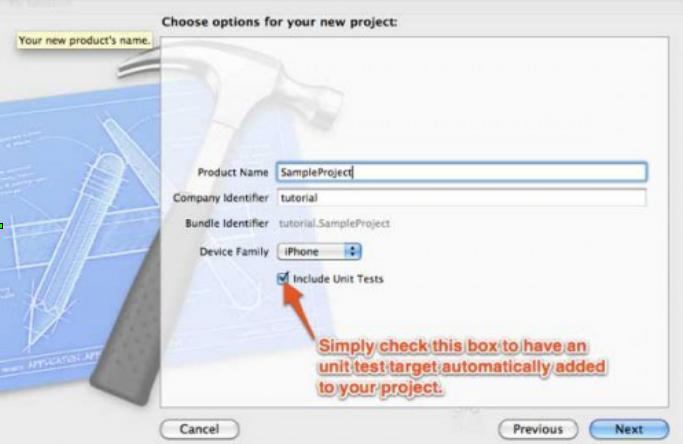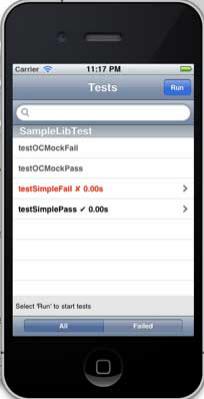Unit
Testing in 4 iPhone, Xcode 4 Unit Testing in Quick Start Guide I
Phone
Unit
Testing is too much required because it is very helpful for our
quality. Easier so that we can deliver high quality of code and also
easier to done edits without any tension of breaking anything.
But what
is not easy here, that is those who didn't started so we are
providing here for those who are the new for this. This tutorial is
all about for those.
 |
| Xcode project set up for unit testing |
Here we
shall cover up how we can set up the Xcode to use following three
different -2 frameworks of unit testing:
- OCUnit : This is unit testing framework created in Xcode
- GHUnit : This is the third party frameworks with some other cool features.
- OCMock: This is used to write the mock object to add tricky testing scenarios
Lets
Starts with OCUnit:
Build
straights into Xcode is used to create unit testing frameworks is
called OCUnit, So we will try it first. In Xcode, Visit on following
location → File \ New \ New Project, Now just select the iOS \
Application \ View base Applications and then click on Next. Now
provide the name of project as TestProject, Also
need to confirm the check the option of Include Unit Test, Please see
the below screenshot -:
 |
| Xcode Project Unit Testing |
Now
click on Next and Select a required folder on specific place then
Click Create.
You
can see at created project, you shall see that Xcode has been created
two targets for us: Sample Project (The app target) and Sample
Project Tests(the unit test target)Unit test target is dependent on
app target. This way when we run the test the apps target will
automatically built up.
 |
| Unit Testing in 4 iPhone |
For
example Single test class has been created by the Xcode for you,
which can be fine in SampleProjectTest \ SampeProjectTest.m. You
shall watch a single tests case se up in available file which will
look like this :
-
(void)testedExample
{
STFail(@"Unit
test is not implemented yet in SampleProjectTest");
}
This
basic sample test should fail on the first step of execution becaue
unit tests are not created till yet.
So
let us try to do this and watch if it required fails as it should.
Select your iPhone simulator from the Scheme drop down, Now choose
Projduct \ Test from the Xcode manu.
Apps
target will be build by the Xcode, then again build the target of
unit test. If
both targets can be built it then runs the test cases on the
simulator and highlights any failures in the Issue Navigator and in
the source file itself, just like it does with build warnings and
errors.
So
as we can see that setting for unit testing with the help of OCUnit
in Xcode is not hard and its really easy task. So it is just a thing
of select the check box.
Why
we prefer GHUnit instead of OCUnit:
→ GHUnit
will allow us to execute all types of test cases, a single test or
just the failed test but OCUnit will allow only execute all of them.
→ The
category of GHUnit is the neat test runner apps, so it quickly show
the high level of view passing and fail tests. While OCUnit does not
have such thing.
→ GHUnit
is like a open source project so we can edit the frameworks to make
it better to meet our requirement.
Now
OCMock:
Mock objects allow us to tests the interaction with the outside
world while keeping external dependencies as low as possible. If our
code has external dependencies or responsibilities (and most do),
then we shall want to use these!
So
OCMock framework for OSX and iOS develop by Mulle that follow the
parrerns of mock framework develop for other platform.
So
we shall learn how to set up the Xcode to uses this along with the
GHUnit.
GHUnit
and OCMock Installation:Instruction
provided here will help to create a structure of project with all
such files saved in the real project directory, containing GHUnit and
OCMock framework. We assume these instructions are those you create
or download in the directory ~/myproj, but feel free to put them
wherever we want.
After
each steps in the running process, we should need to keep clean,
build and execution for each targets to validates the configurations
and dependencies.
Now
lets Started:
Creating fresh directory and the project
→ In
the home directory just need to create sub -directory myprojTests
→ Open
the Xcode and generate the new view base application
→ Just
leave the “Include Unit Test” check box unchecked since you will
be using the GHUnit instead of OCUnit
→ Now
finally Save the project as myprojTests in ~/myprojtests
→ Confirm
that project builds and executes in the simulator without any issue
or error
Integrating
GHUnit
Let's
integrate it -:
- Add a GHUnit Test Target:- First of all you required to add to our project for GHUnit. From the Project Navigator View select the project file, and then click on the Add Target target test.
- Now Create an iOS View based application named 'MyProjTest' for the GHUnit target. Just leave the contains unit test check box unchecked.
Add
GHUnitIOS Framework:
Our
Next step is to adding GHUnit Framework. Make sure that selected is
the latest iOS version which you are going to use.
We
required to includes the full set of file into our projects.
- Configure GHUnit Test The Target: The frameworks of GHUnitIOS has an app delegate and embedded window, so we require to removed the ones installed by default whenever create the target of test.
- First, delete the all files MyProjTestsAppDelegate.h, MyProjTestsAppDelegate.m, MainWindow.xib, MyProjTestsViewController.h, MyProjTestsViewController.m, MyProjTestsViewController.xib, and main.m from MyProjTest
Next,
remove the “Main nib file base name” property from
MyProjTests-Info.plist.
So
Now, added the files to the MyProjTests target, and make sure to
select the MyProjTests target when adding the files.
Finally,
You required to update the build setting for the MyProjTests target.
Now Select “Other Linker Flags” under MyProjTest and added the
value “-ObjC -all_load”
Congratulations
– you have successfully installed GHUnit! Execute the MyProjTest
target in the simulator and you shall watch the GHUnit test runner:
 |
| Installation of GHUnitIOS.framework |
Lets
Create Simple Test Case for iPhone:
AS
we not not any test case till yet but GHUnit has been integrated
previously. So now let us make a simple test case for above work.
First
need to create a New Objective-Cclass Sample Test Case.m in the
MyProjTest group, to make sure that it belong to the MyProjTest
target, as it not to the MyProj targets.
See
out test cases classes doesn't require a header file. Actually Xcode
4 doesn't allow us the option to create only a .m file, so need to
remove the SampleTestCases.h file and also need to change the entire
content of the SampleTestCase.m with the provided following code:
#import
<GHUnitIOS/GHUnit.h>
@interface
SampleLibTests :
GHTestCases {
}
@end
@implementation
SampleLibTests
-
(void)testSimplePasses
{
//
Another test
}
-
(void)testSimpleFail
{
GHAssertTrue(NO,
nil);
}
@end
Now
just press the Run button from the top right corner to execute the
tests
– Here
one test case should succeed and one should be fail.
Creating
a new test cases in GHUnit is the straight forward, such test cases
have simply a method that follow the following simple rules:
→
Classes
inherit from the GHTestCase
→
Return
type of method is void
→
Method
name begin with the 'test',
→
and
function take no argument
Obviously,
to become a useful test cases, it requires to do something (unlike
the 'testSimplePass' method above.)
Each
test case should have a single purpose, and often after all the setup
is done it only checks a single value. It can be as simple as
creating an instance of the class to be tested, calling a method on
that class, and checking that the value returned matches your
expectations.
OCMock
Addition:
Now
we have the setup for GHUNit and executing, We like to submit support
for OCMock. The frameworks available on the websites that does not
work with iOS projects.
Let's
add the OCMock →
Project
Navigator in Xcode, Right click on MyProj and then choose the “Add
Files to 'MyProj'”:
Choose
the directory ~/myproj/MyProj, and then click on the “New Folder”
button. Add a name as “Libraries” for folder and again click on
the “Create” button. As soon as folder is created, Click to 'Add'
to add it to the target folder or location.
Now
adding the OCMock is just a three steps ahead to your project →
- Install the latest OCMock iOS library
- Extract header file from the OCMock frameworks
- Need to Update the build Setting for MyPRojTest
Simple
Test Cases with the OCMock:
Now
we need to add some test cases that use OCMock to our SampleTestCase.
Update SampleTestCase.m to look like this:
#import
<GHUnitIOS/GHUnit.h>
#import
<OCMock/OCMock.h>
@interface
SampleLibTests :
GHTestCases {
}
@end
@implementation
SampleLibTests
-
(void)testSimplePasses
{
//
Another test
}
-
(void)testSimpleFail
{
GHAssertTrue(NO,
nil);
}
//
simple test to ensure building, linking,
//
and running test case works in the project
-
(void)testOCMockPasses
{
[[[mock
stub]
andReturn:@"mocktest"]
lowercaseString];
GHAssertEqualObjects(@"mocktest",
returnValue,
@"Should
have returned the expected string.");
}
-
(void)testOCMockFail
{
[[[mock
stub]
andReturn:@"mocktest"]
lowercaseString];
GHAssertEqualObjects(@"thisIsTheWrongValueToCheck",
returnValue,
@"Should
have returned the expected string.");
}
|
And
finally, run the MyProjTest target in the simulator and it should
look like this:
 |
| Simple Test Cases with the OCMock |









No comments:
Post a Comment